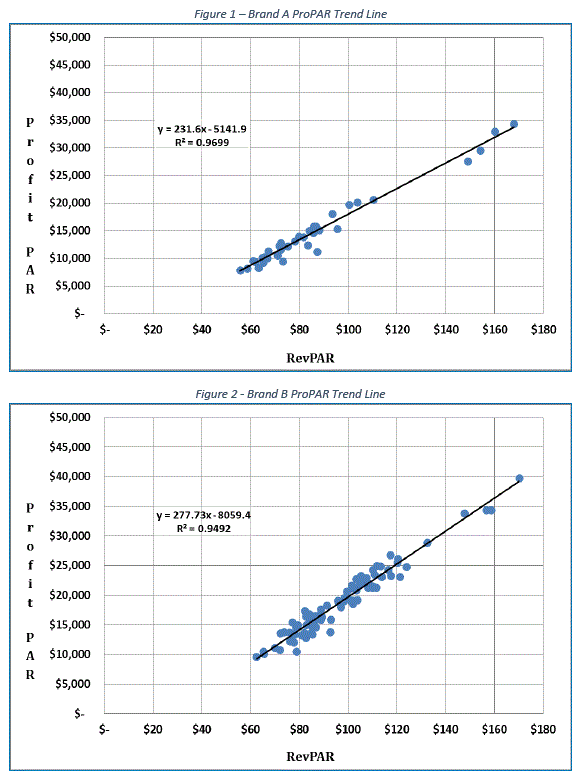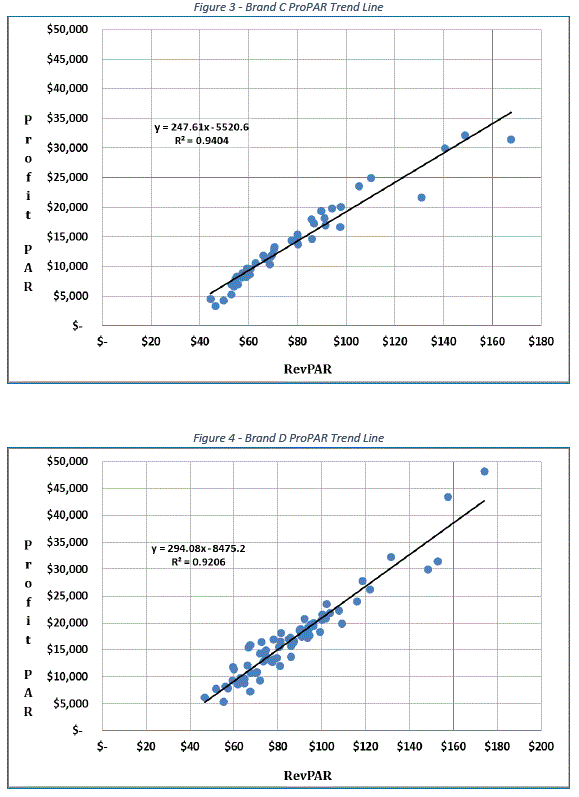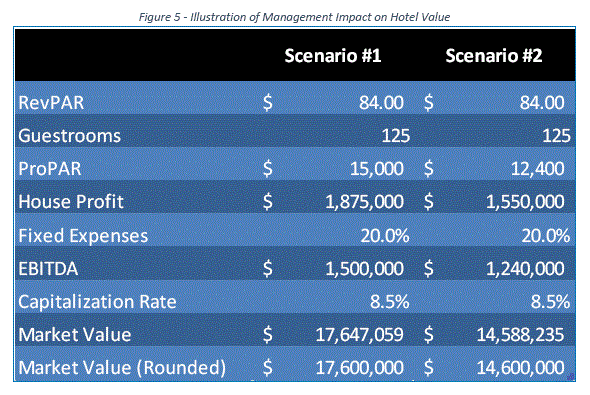by Hans Detlefsen and Emiliia Gordiienko
Introduction
Hotel Appraisers & Advisors (HA&A) recently completed our 2015 Hotel Management Company Benchmark Analysis. The study was designed in response to a series of questions we frequently hear from our clients in the hotel industry. These developers and investors seek our help identifying hotel operators and negotiating hotel management contracts. They ask us: Aren’t most hotel management companies basically the same? How much does it really matter which operator we select? Is there any quantitative data suggesting that different management companies produce different profitability results?
In an effort to address these questions, HA&A collected more than 500 proprietary financial statements from a broad range of hotel management companies that operate hotels in the United States. We analyzed this financial data to determine whether the participating management companies achieve roughly the same results, or differing results, in profitability. To normalize for variables such as hotel age, location, branding, construction quality, and service level, we looked at each hotel’s profit¹ per available room (ProPAR). We also focused on a selection of highly-standardized hotel brands. This article summarizes some of the key findings from our proprietary study. Participation in the study is confidential and ongoing. Although the authors actively solicited participation from 40 top hotel management companies, the study is open to all hotel management companies and ownership groups operating in the United States.
The basic conclusion of our study is that the management company you choose can significantly affect your hotel’s profit margin. Different management companies produced significantly differing levels of profitability, after accounting for factors affecting revenue per available room (RevPAR). Even within the same brand, properties with virtually identical top-line revenues produced very different bottom-line profits, indicating substantial variability in the abilities of different management companies to control expenses. Some management companies appear to shine within particular geographic regions and others demonstrate an ability to achieve above-average profit margins when managing certain brands.
The fact that our study was weighted towards a sub-set of highly skilled management companies, and we still found substantial levels of variability in performance, supports the authors’ conclusion that selecting the right management company is critical for owners who want to maximize the value of their hotels.
Can We Predict House Profit if RevPAR and Brand are Known?
To test our hypothesis that management companies matter, the authors assumed the opposite hypothesis and tested it. If all hotel management companies are pretty much the same, then RevPAR and branding should be more important than management. When comparing two like-branded hotels that both achieve the same RevPAR, one might expect them to have similar profits, at least on a per-available-room basis. Since the most popular U.S. hotel brands each require strict implementation of operating procedures, brand standards, and staffing protocols, we might expect profit margins to be very similar once a hotel’s brand and RevPAR level is determined. Stated differently, we wanted to test the hypothesis that we can predict a hotel’s house profit if we are given the following two variables:
1. Brand
2. RevPAR
To test this hypothesis, HA&A evaluated detailed financial statements from four popular hotel brands, with wide distribution in the United States. The following four figures illustrate RevPAR versus ProPAR for each of these four brands included in our analysis.

In the preceding graphs, the black trend lines represent the linear regression models that most closely fit the actual profit data for each brand. These models appear to explain more than 92.0% of the variability in profits for the hotels in our sample. However, up to 8.0% of the variability is not explained by our models. (The unexplained portion is even higher for other brands we analyzed.) While some readers may conclude these data fit our models very well, many sophisticated investors make a living exploiting much smaller arbitrage opportunities than these.
Hotel management companies’ skill levels in controlling operating expenses is likely a primary factor in explaining the remaining variability in house profits. By using well-honed operating procedures, taking advantage of scale, building a sustainable training and recruitment process, and by spreading the costs of asset management and other administrative tasks across a portfolio of multiple hotels, some hotel management companies are able to produce superior profits for a given revenue level.
What about a property’s condition, age, or location? Don’t these factors affect a hotel’s profitability? Yes. However, these factors are already accounted for in our models because we account for RevPAR.² That is, if one property is in a better location than another, then this should already be reflected in its RevPAR. Similarly, if one property is in better condition or newer than another, then RevPAR should also reflect this difference. As such, normalizing for RevPAR allows us to account for all of these potential differences between hotels with a single variable.
So, are we able to predict house profit if we know only the RevPAR and brand of a hotel? Not very well. Even the most standardized U.S. hotel brands produce significant variability in profits when compared to the trend lines shown. The management company’s skill is an additional critical variable that can affect how well a hotel’s expenses are controlled, thereby affecting profit margins. There may also be additional omitted variables not discussed in this article.
Do Management Companies Matter?
As we have seen, there can be substantial differences in profits between hotels, even when they share the same brand and achieve identical RevPAR levels. We interpret this as evidence to suggest that the selection of your hotel’s management company can matter a great deal. We provide the following illustration to highlight this conclusion.
Let’s assume you’re building a 125-room hotel and it will be branded as “Brand A” from the preceding Figure 1. After completing your feasibility study, let’s say you determine your hotel’s stabilized RevPAR is expected to be $84.00 in current dollars. Figure 1 indicates that the highest and lowest performers within this brand, at the projected RevPAR level, achieved house profit levels of approximately $15,000 and $12,400, respectively. The following figure illustrates what this discrepancy could imply for the value of your hotel.
In this example, achieving a ProPAR similar to the top performer (Scenario #1) implies a market value of approximately $17.6 million. By contrast, achieving a ProPAR similar to the bottom performer (Scenario #2) implies a market value of approximately $14.6 million. With the same brand and same RevPAR levels, therefore, factors such as management skill (and other possible factors) could imply approximately $3.0 million in value for the owner. Even if management skill only explains a portion of this difference, it is still likely to be one of the biggest factors within the owner’s control that significantly affects the hotel’s market value.
Concluding Thoughts
This article is intended to invite further discussion among industry professionals about the factors that affect hotel profit margins and values. The authors hope the findings shared in this article represent some small contribution to a broader discussion in the industry about how management company selection and other factors can affect hotel profitability.
With respect to the importance of selecting a top management company, owners should evaluate a management company both on its ability to control operating expenses and its ability to maximize top-line revenues. This article has focused primarily on how a management company’s skills pertaining to expense-controls can affect hotel values and profitability.
The selection of top management companies can also significantly affect hotel value through management’s ability to maximize revenues. Although it is not the focus of this article, some data in our analysis suggests that management skill may have a significant impact on a hotel’s ability to achieve its top-line RevPAR potential. For the four brands shown in this article, the properties included in our sample produced RevPAR levels approximately 4.0% higher than the U.S. averages for those brands. This may imply that participants in our study were more skilled at maximizing top-line revenues than the average hotel management company. The authors welcome participation from additional management companies and ownership groups who are interested in receiving confidential benchmarking feedback.³
___________
¹ For the purpose of this article, we use the term “profit” to mean gross operating profit, which is also sometimes referred to as house profit.
² RevPAR may not perfectly accounts for all of these factors; however, it is a useful and simple proxy.
³ Please contact Hans Detlefsen at (312) 526-3885 or hdetlefsen@hotelappraisers.com if you represent a hotel management company or ownership group and would like to be included in this benchmarking analysis. All participating companies remain anonymous and receive a confidential copy of their hotel portfolio’s ProPAR trend lines versus the national average trend lines for each brand in their portfolio.



